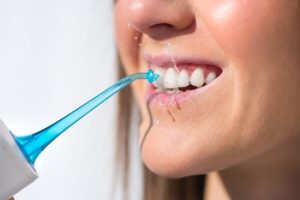In an age where dental health is paramount, the water flosser has emerged as a revolutionary tool against gum disease and poor oral hygiene. However, one question often arises in households across Australia: can you share a water flosser? This inquiry touches upon the effectiveness of water flossers and delves into hygiene and personal health safety.
Understanding Water Flossers

Water flossers, a cornerstone of modern oral hygiene, have revolutionised how we approach dental care. Known also as oral irrigators, these devices harness the power of a pulsating water stream to meticulously clean between teeth and beneath the gum line, effectively removing food particles and plaque. This section delves deeper into the workings, benefits, and varieties of water flossers, offering insight into their pivotal role in maintaining oral health.
The Mechanism of Water Flossers
Understanding the mechanism behind water flossers reveals why they significantly advance dental care. At the core of every water flosser is a precision-engineered motor. This motor generates a pulsating stream of water through a meticulously designed tip. When this stream is aimed between teeth and along the gum line, it acts remarkably efficiently, dislodging and removing food debris, plaque, and bacteria that traditional brushing and flossing methods might miss.
At the heart of a water flosser is a motor that generates a pulsating stream of water through a tip. When aimed between teeth and along the gum line, this stream dislodges and removes food debris, plaque, and bacteria with remarkable efficiency.
Clinical oral investigations have lauded water flossers as a significant advancement in dental care, particularly highlighting their effectiveness for individuals undergoing orthodontic treatment. Braces, retainers, and other dental appliances can create nooks and crannies that are challenging for traditional dental floss to clean. Water flossers easily navigate these complexities, offering a thorough cleanse without the risk of damaging orthodontic work.
The pulsation of the water stream is key to the device’s effectiveness. It creates a forceful yet gentle pressure that can penetrate deep between teeth and below the gum line, areas often neglected by conventional dental floss and toothbrushes. This capability makes water flossers an invaluable tool for enhancing oral hygiene, ensuring a cleaner mouth with reduced gum disease and tooth decay risks.
Clinical oral investigations have consistently praised water flossers, noting their particular benefits for individuals with orthodontic treatments. Braces, retainers, and other fixed appliances introduce new challenges for maintaining oral hygiene, creating spaces that are difficult to clean with traditional methods. Water flossers excel in these situations, providing a safe and effective way to clean around wires and brackets, reducing the risk of plaque buildup and gum disease without the threat of causing damage to the orthodontic work.
Moreover, the design of water flosser tips is tailored to navigate the unique contours of the mouth, ensuring that even the most difficult-to-reach areas receive thorough attention. This attention to detail in design and functionality underscores the water flosser’s role as a critical component of modern dental hygiene practices, offering a level of cleaning beyond what traditional methods can achieve.
Varieties of Water Flossers
Water flossers are not a one-size-fits-all solution; they come in various models designed to meet different preferences and requirements:
Countertop Water Flossers: These are the most common and versatile models, featuring adjustable pressure settings for varying sensitivity levels. They are ideal for home use, providing a steady, reliable performance. However, their size requires a designated space on your bathroom countertop.
Cordless Water Flossers: Cordless water flossers are perfect for those with limited space or need a travel-friendly option. They are compact, battery-operated, and often waterproof, making them suitable for use in the shower.
Faucet-Connected Water Flossers: These models attach directly to a faucet, drawing water straight from the tap. They eliminate the need for a reservoir, providing an unending water supply for flossing. This setup is ideal for those who prefer not to refill a water tank or deal with recharging batteries.
Benefits of Water Flossers

Water flossers have become an indispensable tool in the realm of dental care, offering a myriad of benefits that extend beyond the capabilities of traditional dental floss and toothbrushes. These devices are designed to enhance oral hygiene, employing a pulsating water stream to clean notoriously inaccessible areas. Below, we delve into the advantages of water flossers, highlighting their effectiveness in promoting oral health.
Enhanced Cleaning Efficiency
Reaching Difficult Areas: One of the standout benefits of water flossers is their ability to reach and clean areas that traditional dental floss and toothbrushes often miss. The pulsating action of the water stream effectively dislodges food particles and plaque from between teeth, along the gum line, and in other hard-to-reach areas, such as the back of the mouth and interdental spaces.
Prevention of Plaque Buildup: Regular water flosser helps prevent plaque buildup, a sticky film of bacteria that can harden into tartar if not removed. By eliminating plaque, water flossers play a crucial role in preventing tartar formation, cavities, and gum disease, thereby contributing to overall dental health.
Promoting Gum Health
Stimulating Gum Tissue: Beyond cleaning, the pulsating water stream from a water flosser stimulates gum tissue, promoting better blood circulation. This stimulation is vital for maintaining healthy gums, as it can help prevent the onset of gum disease, a common condition that can lead to tooth loss if left untreated.
Gentle on Sensitive Gums: Water flossers offer a gentle yet effective alternative for individuals with sensitive gums or those prone to bleeding when using traditional dental floss. The ability to adjust the water pressure means that users can find a comfortable setting that cleans effectively without causing discomfort or bleeding, making it a suitable option for those with gum sensitivity.
Versatility and Convenience
Customisable Settings: Many water flossers come equipped with adjustable pressure settings and various flossing tips, allowing users to customise their flossing experience. This versatility makes water flossers suitable for a wide range of users, including those with braces, dental implants, or other dental work that requires care.
Ease of Use: Water flossers are also praised for their ease of use, offering a straightforward and efficient way to floss that can be more appealing than traditional methods. This ease of use can encourage more regular flossing, contributing to better oral hygiene practices overall.
Hygiene Concerns with Sharing Water Flossers
Oral health is fundamentally linked to rigorous hygiene practices, a principle especially true regarding personal hygiene devices like water flossers. While these devices are instrumental in maintaining good oral hygiene, sharing them can pose significant health risks. This section explores the hygiene concerns of sharing water flossers, the risk of pathogen transmission, and the implications for those with gum disease or weakened immune systems.
The Risk of Pathogen Transmission
Water flossers are designed for individual use primarily because they come into close contact with the mouth, saliva, and potentially blood. The moist environment within a water flosser tip and reservoir can become a breeding ground for bacteria and viruses if not properly cleaned and disinfected. When shared, these devices can facilitate the transfer of pathogens, including those responsible for causing gum disease, tooth decay, and other oral infections.
Saliva as a Carrier: Saliva can carry many bacteria and viruses. Sharing a water flosser tip without proper sterilisation between uses increases the risk of cross-contamination. This risk is heightened if one user has an active oral infection, as pathogens can easily be transferred to the next user.
Implications for Gum Disease: Individuals with gum disease are particularly vulnerable since their condition often involves bleeding gums, providing a direct pathway for pathogens to enter the bloodstream. Sharing water flossers in such cases not only risks the health of the individual with gum disease but also poses a risk to others who may use the device subsequently.
Health Concerns for Immunocompromised Individuals
The dangers of sharing a water flosser extend beyond the immediate risk of oral infections. For individuals with compromised immune systems—due to conditions such as diabetes, HIV/AIDS, or the effects of chemotherapy—exposure to even seemingly benign bacteria can have serious health implications. The immune system’s reduced capacity to fight off infections makes these individuals particularly susceptible to the pathogens that might be present on a shared water flosser.
Best Practices for Water Flosser Hygiene
Adhering to stringent hygiene practices is paramount to mitigating the risks of sharing water flossers. While the ideal scenario is one water flosser per person, situations may arise where sharing is unavoidable. In such cases, the following precautions can help maintain the highest possible hygiene standards:
- Individual Tips: If a water flosser must be shared, ensure each user has their tip. This reduces the risk of direct pathogen transmission.
- Regular Disinfection: Disinfect water flosser tips after each use. Soaking the tips in a disinfectant solution or using a UV steriliser can kill bacteria and viruses.
- Proper Storage: Store water flosser tips in a clean, dry environment to prevent bacterial growth. Avoid damp locations like bathrooms, where pathogens can thrive.
- Routine Maintenance: Follow the manufacturer’s guidelines for cleaning the water flosser unit and reservoir. Regular maintenance prevents the buildup of biofilm and other contaminants.
Manufacturer’s Guidelines on Sharing

Leading manufacturers provide clear guidelines on sharing their devices. While multiple individuals can use the main unit, it is strongly recommended that each user has their water flosser tip. This practice ensures that oral hygiene is not compromised. Most water flossers have a tip eject button, making it easy to switch tips between uses.
Safe Practices for Sharing a Water Flosser
When sharing a water flosser is necessary, implementing a set of safe practices can significantly reduce health risks associated with cross-contamination. These practices are designed to ensure that even when multiple individuals use the same device, they can maintain a high standard of oral hygiene without compromising their health or the health of others. Let’s delve into these precautions more detail, highlighting the importance of personal tips, thorough cleaning, and regular sterilisation.
Assigning Personal Water Flosser Tips
Individual Use: The most effective way to minimise the risk of cross-contamination is by assigning a specific water flosser tip to each user. This approach ensures that each person’s bacteria and potential pathogens are not shared with others.
Identification: Each tip should be distinctly marked or colour-coded to prevent mix-ups. Many water flosser models come with tips in various colours precisely for this purpose, making it easier for family members or roommates to identify their own tips quickly.
Thorough Cleaning of Water Flosser Tips
Rinse After Use: Immediately rinsing the water flosser tip with warm water after each use helps remove saliva, bacteria, and food particles that might have adhered during flossing. This step is crucial for maintaining the tip’s cleanliness and readiness for the next use.
Disinfection: Periodic soaking of the flosser tips in a disinfectant solution, such as hydrogen peroxide or an antimicrobial mouthwash, further eliminates pathogens. This practice should be performed regularly, depending on the frequency of use and if the flosser is being shared among multiple individuals.
Regular Sterilisation of the Device
Following Manufacturer’s Instructions: Adhering to the cleaning and maintenance guidelines provided by the water flosser’s manufacturer is essential. These instructions are designed to keep the device in optimal condition, extending its lifespan while ensuring it remains hygienic for shared use.
Use of Plain Warm Water: Some manufacturers recommend running plain warm water through the water flosser after each use. This simple practice can help flush out any remaining debris and bacteria from the water path and nozzle, reducing the risk of biofilm formation within the device.
Sterilisation Techniques: Consider using UV sterilisers specifically designed for dental equipment for thorough sterilisation. These devices can offer additional protection against microbes, ensuring the water flosser remains safe for multiple individuals.
Alternatives to Sharing a Water Flosser

Ensuring optimal oral health while mitigating the risks of sharing personal hygiene devices like water flossers calls for exploring viable alternatives. The goal is to maintain the benefits of water flossing for each individual without the hygiene compromises that can come from shared use. Two effective strategies are investing in individual devices for each family member and seeking affordable models without skimping on quality. Let’s expand on the importance of these alternatives in promoting individualised and effective oral care.
Investing in Individual Devices
Personalised Oral Hygiene: Providing each family member with their own water flosser ensures that everyone can follow their oral care routine without cross-contamination. This approach is particularly beneficial in families where members may have different oral health needs, such as varying sensitivities, orthodontic treatments, or susceptibility to gum disease.
Encouraging Regular Use: Having a personal water flosser can also encourage more frequent use, as the convenience of having a dedicated device removes barriers to regular oral hygiene practices. This consistent use is key to achieving the full benefits of water flossing, including reduced plaque buildup, healthier gums, and a lower risk of tooth decay.
Seeking Out Affordable Models
Cost-Effective Options: The market for water flossers is diverse, with options ranging from premium models with advanced features to more basic yet effective units that are friendly on the wallet. Researching and comparing products can reveal that quality can come at a low price. Many affordable water flossers offer essential functions for effective oral hygiene, such as adjustable pressure settings and various flossing tips.
Prioritising Essential Features: When looking for a cost-effective water flosser, prioritise the most important features for your oral health needs. For instance, a cordless model might be the best choice if portability is key. Alternatively, if multiple flossing modes are essential to accommodate sensitive gums or orthodontic work, look for models that offer these settings at a competitive price.
Conclusion
The discussion on whether you can share a water flosser highlights the importance of balancing convenience with hygiene and health safety. While water flossers are invaluable in maintaining oral health, especially in preventing gum disease and removing food debris, sharing them poses significant hygiene concerns. Following manufacturer guidelines and adopting safe practices can mitigate some risks, but the ideal scenario is for each individual to have their device. This approach ensures the effectiveness of water flossing in achieving good oral hygiene and safeguards against the transmission of harmful pathogens.
In our journey towards optimal dental health, embracing innovations like the water flosser while adhering to strict hygiene practices is crucial. Whether utilising power-driven water flossers or integrating traditional flossing and interdental brushes into our routines, the goal remains: to remove plaque and food particles and maintain a healthy gum line.
As we navigate the complexities of oral health, let’s remember the value of individual responsibility and the role of advanced dental tools in our daily lives. With its ability to reach hard-to-reach areas and provide deep cleaning, the water flosser represents a significant leap forward in dental care. Yet, its shared use must be cautiously approached, prioritising health and hygiene.
Oral health is a journey best navigated with the right tools and knowledge. If you want to enhance your dental care routine with a water flosser or have questions about maintaining optimal oral hygiene, Beyond Infinity Dental is here to assist you. Our team of experts is dedicated to providing you with the best advice and solutions tailored to your specific needs. Don’t let doubts keep you from achieving the pinnacle of oral health. Contact Beyond Infinity Dental at (02) 8806 3799 today and take the first step towards a healthier, brighter smile.
References:
https://www.ncbi.nlm.nih.gov/pmc/articles/PMC8816322/
https://www.aegisdentalnetwork.com/adn/cced/2020/03/efficacy-of-the-use-of-a-water-flosser-in-addition-to-an-electric-toothbrush-on-clinical-signs-of-inflammation-4-week-randomized-controlled-trial










